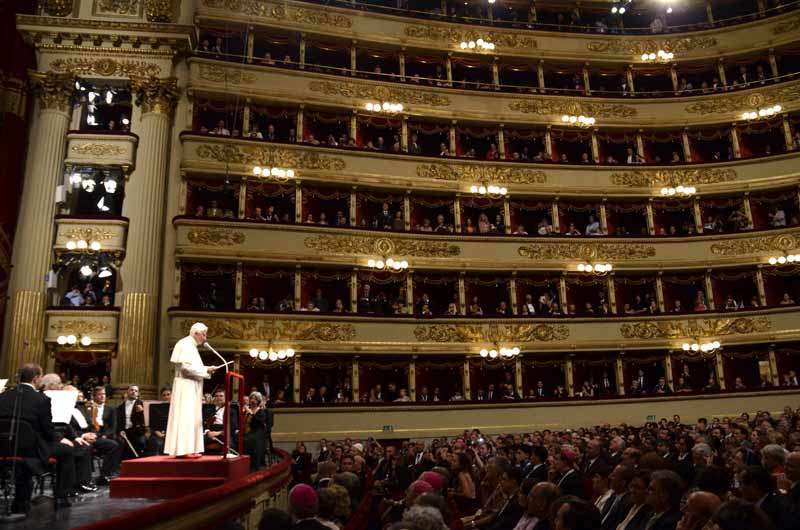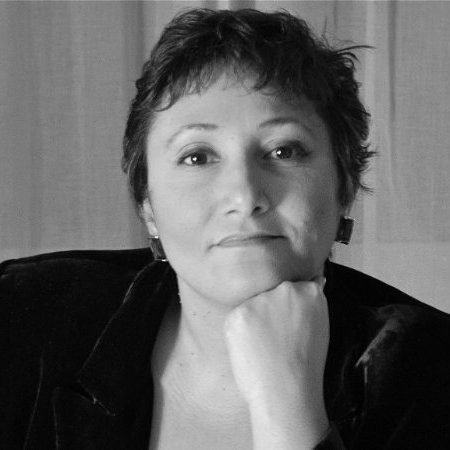
"Music, great music, relaxes the spirit, arouses deep feelings, and almost naturally invites us to raise our minds and hearts to God in every situation of human existence, whether joyful or sad. Music can become prayer." These were the words of Benedict XVI on Oct. 17, 2009, after attending a concert by the Imola International Piano Academy in the Aula Nervi in the Vatican. And, a few days later, on Nov. 21, addressing the artists gathered in the Sistine Chapel - there were about 250 writers, painters, actors, directors and musicians - he said in a memorable speech, "You are custodians of beauty; you have, thanks to your talent, the possibility of speaking to the heart of humanity, of touching individual and collective sensibilities, of arousing dreams and hopes, of broadening the horizons of knowledge and human endeavor."
Beauty was one of the most reoccurring themes in the magisterium of Benedict XVI who, a few months after his election as pontiff, for the presentation of his Compendium of the Catechism of the Catholic Church, wrote: "Image and word thus illuminate each other. Art always speaks, at least implicitly, of the divine, of the infinite beauty of God, reflected in the Icon par excellence: Christ the Lord, Image of the invisible God. Sacred images, with their beauty, are also a proclamation of the Gospel and express the splendor of Catholic truth." These are words, concepts, and images that stand in the wake of his two illustrious predecessors - John Paul II and Paul VI - who both lived close to the world of art and beauty. Benedict XVI, ascending to the Petrine throne, inherited this dialogue with the artistic universe and made it properly his own, integrating it with his theological studies: one can, therefore, rightly speak of Ratzinger also as a "theologian of art."
His passion for beauty and - above all - for music had deep roots: "As I look back on my life, I thank God for having placed music next to me almost like a traveling companion. It has always offered me comfort and joy," he said on April 16, 2007, at a concert for his 80th birthday. The musical passion came from his family; it was a passion he would never abandon: he cultivated it during his priesthood years and continued his passion even as Peter's successor. The picture of him at the piano in his papal vestments has gone around the world, with that attentive look at the score and with a posture of a "consummate" concert pianist. The photo was taken in the summer of 2005 during a brief vacation in Les Combes, in the Aosta Valley, in the same chalet where his predecessor John Paul II went. The notes he was playing were those of Johann Sebastian Bach, the "master of masters" as the Bavarian pontiff called him. He had dedicated a portrait to the German composer at a concert in the courtyard of the Apostolic Palace in August 2011, where he spoke as an acute critic and attentive music historian: "Bach is a splendid architect of music, with an unparalleled use of counterpoint, an architect guided by a tenacious ésprit de géometrie, a symbol of order and wisdom, a reflection of God."
The pontiff's "hit parade" included not only Bach but also other illustrious names: composers whose works have made up the history of music of all times; there is room for Wolfgang Amadeus Mozart and Ludwig van Beethoven. Concerning the composer from Salzburg, Ratzinger will say, "In Mozart everything is in perfect harmony, every note, every musical phrase is so and could not be otherwise; (...)the Mozartian serenity envelops everything, in every moment. It is a gift this of God's Grace, but it is also the fruit of Mozart's living faith, which - especially in his sacred music - succeeds in bringing out the luminous response of divine Love, which gives hope, even when human life is torn by suffering and death."
Benedict XVI's commentaries on art - especially music - are never readings dictated by the ceremonial of the present event, but represent, always, true critical readings: they are words dictated by an in-depth study of the musical score or the literary or pictorial work in question, of its historical contextualization; they denote, moreover, a detailed knowledge of the artist; it is surprising how the theologian Ratzinger is able to pass from the purely spiritual field to the mainly technical-executive field of the work with extreme ease. Such is the case with the words reserved for Beethoven's Ninth Symphony, performed in June 2012 at the Teatro La Scala in Milan: "Right from the famous first sixteen bars of the first movement, an atmosphere of expectation of something grandiose is created, and the expectation is not disappointed. Beethoven while basically following the traditional forms and language of the classical symphony, makes one perceive something new already from the unprecedented breadth of all the movements of the work, which is confirmed with the final part introduced by a terrible dissonance, from which the recitative with the famous words “O friends, not these sounds! But let us sing more pleasant and more joyful notes!”
No less present in his speeches are the references to pictorial art: between the Renaissance Michelangelo, author of the Sistine Chapel, in which "he offers to our vision the Alpha and the Omega, the Beginning and the End of history, and invites us to walk the itinerary of life with joy, courage and hope," to the contemporary Chagall "who always testified to the encounter between aesthetics and faith." Benedict XVI, however, does not neglect the art of writing: among the most quoted authors is Dante, who "throughout his entire life professed the Catholic religion in an exemplary way, made himself a disciple of the prince of Scholasticism Thomas Aquinas; and from the very world of religion, he drew reason to deal in verse with an immense and supreme subject"; then Chesterton: a writer of high "human and Christian stature."
The pontificate of Benedict XVI, a hymn to beauty that "precisely because of its characteristic of opening and widening the horizons of human consciousness, of sending it back beyond itself, of overlooking the abyss of the Infinite, can become a path toward the Transcendent, toward the ultimate Mystery, toward God." And it was to Him that he returned exactly one month ago, on December 31, through other Mystery, the highest Mystery, that of death and Resurrection.

Angela is Editor-in-Chief of ACI Stampa. Born in 1965, she holds a philosophy degree and began her Vatican journalism career at Vatican Radio in 1988. She has worked in TV and newspapers and covers the Vatican for various Italian and international media. Angela has published several books with Libreria Editrice Vaticana and TAU on Popes John Paul II and Benedict XVI.
angela.ambrogetti@acistampa.it







